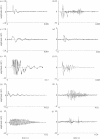Assassin bug uses aggressive mimicry to lure spider prey
- PMID: 20980305
- PMCID: PMC3061146
- DOI: 10.1098/rspb.2010.2060
Assassin bug uses aggressive mimicry to lure spider prey
Abstract
Assassin bugs (Stenolemus bituberus) hunt web-building spiders by invading the web and plucking the silk to generate vibrations that lure the resident spider into striking range. To test whether vibrations generated by bugs aggressively mimic the vibrations generated by insect prey, we compared the responses of spiders to bugs with how they responded to prey, courting male spiders and leaves falling into the web. We also analysed the associated vibrations. Similar spider orientation and approach behaviours were observed in response to vibrations from bugs and prey, whereas different behaviours were observed in response to vibrations from male spiders and leaves. Peak frequency and duration of vibrations generated by bugs were similar to those generated by prey and courting males. Further, vibrations from bugs had a temporal structure and amplitude that were similar to vibrations generated by leg and body movements of prey and distinctly different to vibrations from courting males or leaves, or prey beating their wings. To be an effective predator, bugs do not need to mimic the full range of prey vibrations. Instead bugs are general mimics of a subset of prey vibrations that fall within the range of vibrations classified by spiders as 'prey'.
Figures




References
-
- Wickler W. 1968. Mimicry in plants and animals. London, UK: Weidenfeld and Nicolson
-
- Vane-Wright R. I. 1980. On the definition of mimicry. Biol. J. Linn. Soc. 13, 1–610.1111/j.1095-8312.1980.tb00066.x (doi:10.1111/j.1095-8312.1980.tb00066.x) - DOI - DOI
-
- Edmunds M. 2000. Why are there good and poor mimics? Biol. J. Linn. Soc. 70, 459–46610.1006/bijl.1999.0425 (doi:10.1006/bijl.1999.0425) - DOI - DOI
-
- Lloyd J. E. 1975. Aggressive mimicry in Photuris fireflies: signal repertoires by femmes fatales. Science 187, 452–45310.1126/science.187.4175.452 (doi:10.1126/science.187.4175.452) - DOI - DOI - PubMed
-
- Lloyd J. E. 1984. Occurrence of aggressive mimicry in fireflies. Flor. Entomol. 67, 368–37610.2307/3494715 (doi:10.2307/3494715 ) - DOI - DOI
Publication types
MeSH terms
LinkOut - more resources
Full Text Sources
